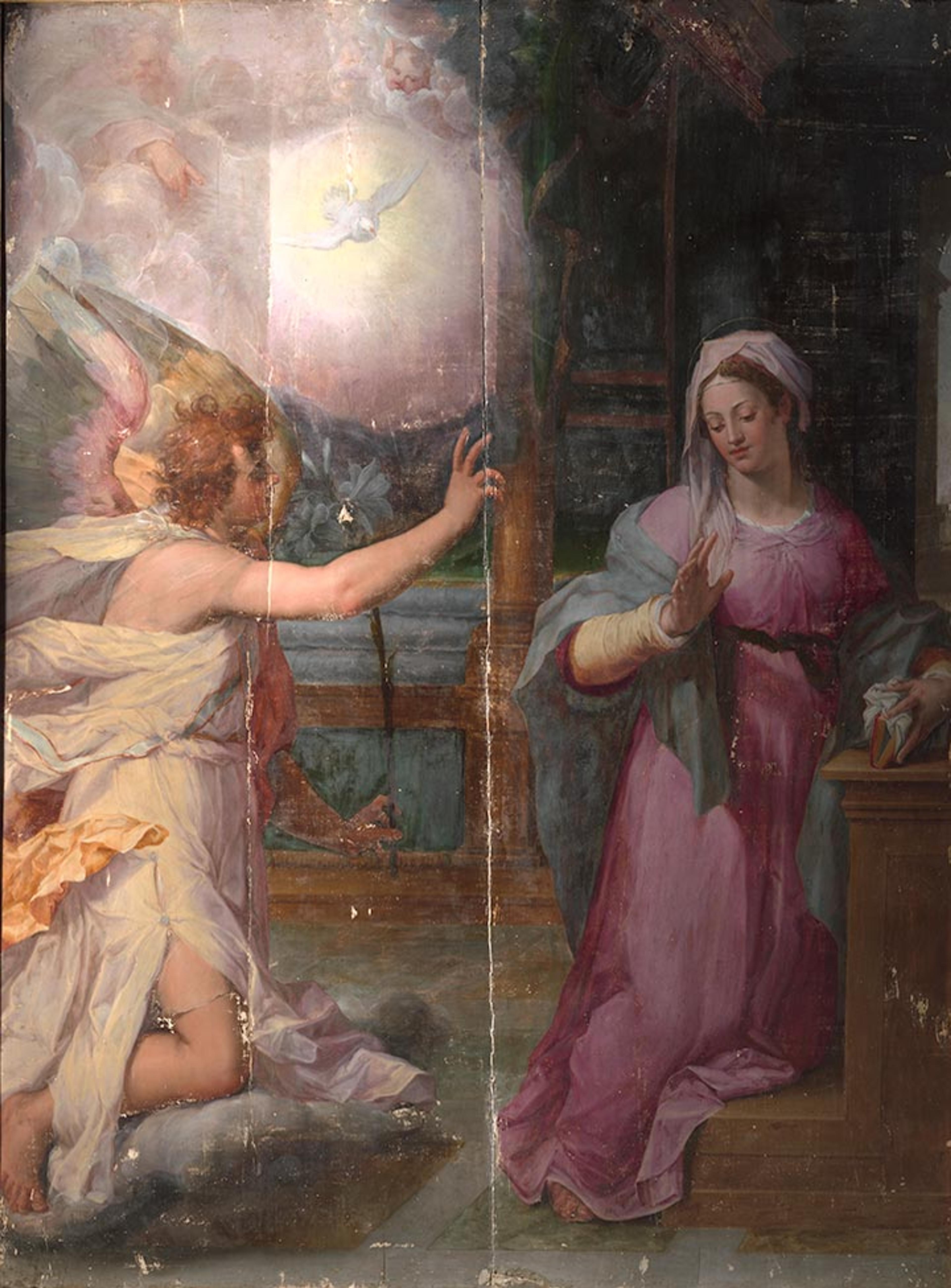
Peter Candid (Pieter de Witte, Pietro Candido) (Netherlandish, ca. 1548–1628). The Annunciation (during conservation), ca. 1585. Oil on wood, 91 1/4 x 68 1/4 in. (231.8 x 173.3 cm). The Metropolitan Museum of Art, New York, Gift of Fabrizio Moretti, in honor of Keith Christiansen, 2011 (2011.75)
«There is an exciting new addition to gallery 609: a monumental altarpiece of the Annunciation by Peter Candid that arrived as a gift to The Met in 2011 and that has been in conservation ever since. This post will be the first in a series that reviews the conservation treatment of this magnificent panel by a number of members of the Department of Paintings Conservation.»
Painted around 1585, Candid's Annunciation was first installed in a country church in Tuscany, and it later made an unexpected journey through Malta and Rome to the College of the Holy Cross in Worcester, Massachusetts, before arriving at The Met in 2011. The artist—whose actual name was Pieter de Witte, but who was better known as "Candido" in Italy and "Candid" in German—painted it for a company dedicated to the Virgin Annunciate that had an oratory annexed to the church of San Martino ad Argiano, near the town of San Casciano Val di Pesa. In their altarpiece, he unleashed all of the qualities he had absorbed from many years of working in Florence and studying its artistic heritage: the composition, including the angel wafting in on clouds, inspired by Andrea del Sarto; the dazzling colors of Pontormo; and the sculptural forms of Giambologna and Michelangelo.
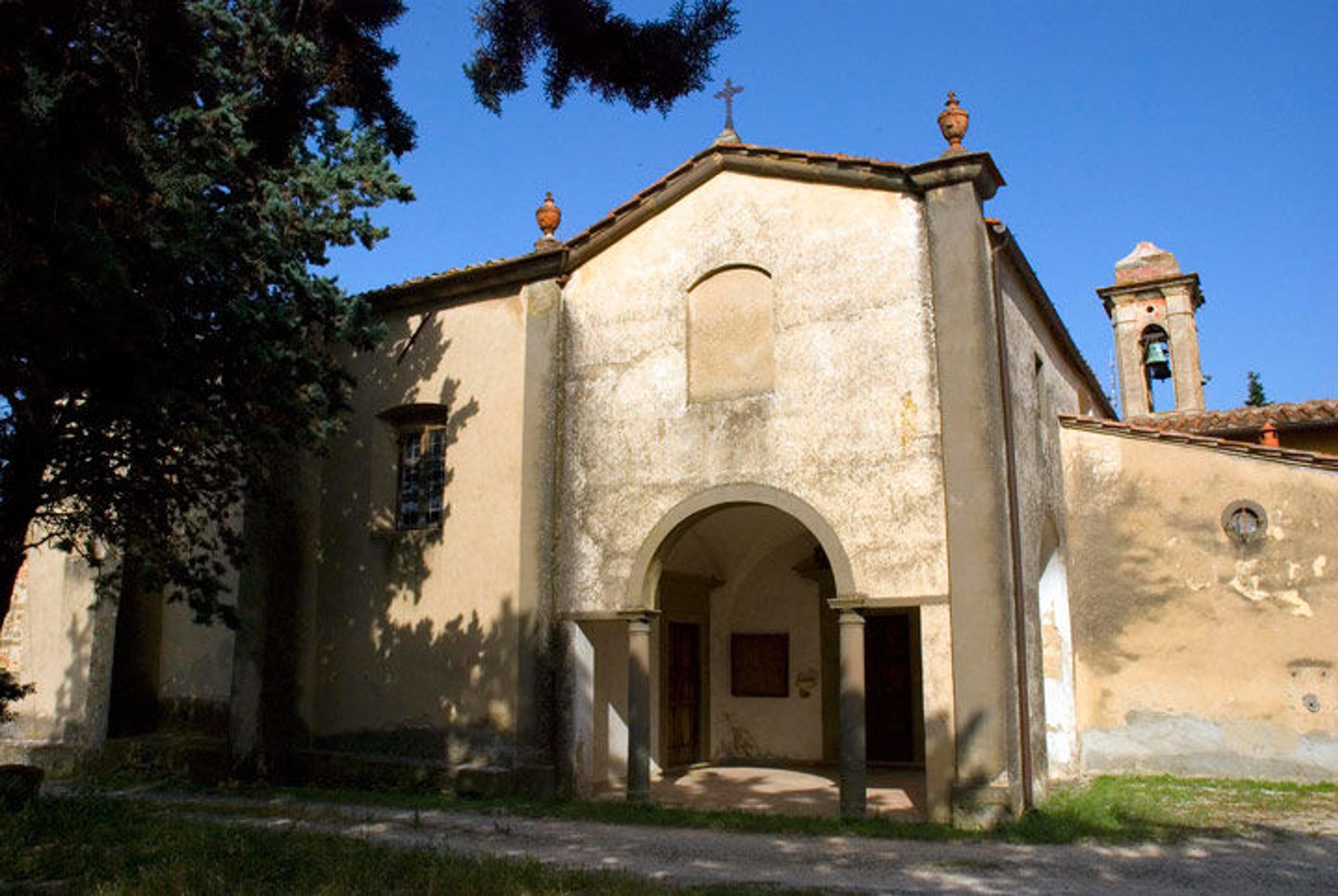
The original home of Candid's Annunication, the church of San Martino ad Argiano, located near the town of San Casciano Val di Pesa in Italy
Candid's Annunciation is painted in oil on a wood panel made of five vertically oriented poplar boards each almost two inches thick. When the panel first entered the studio, Conservator George Bisacca and I examined the back of it and realized that, although it had serious structural issues, it still retained much of its original material and construction, including three horizontal battens dovetailed into the panel at the top, center, and bottom.
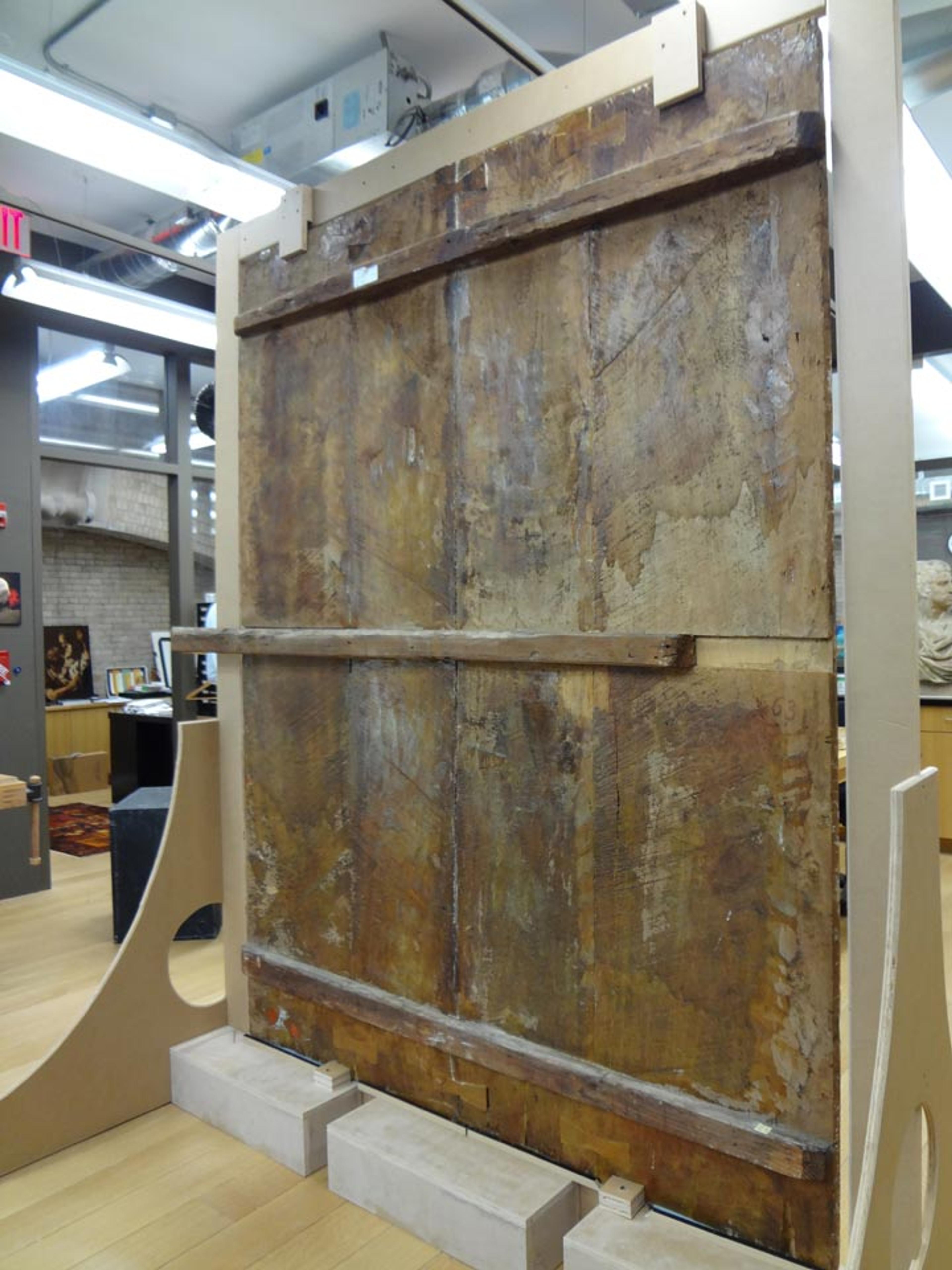
The back of the panel, showing the five vertically oriented poplar boards used in its construction—four wide boards and a narrower one running along the right edge—as well as three horizontal battens. Photo by George Bisacca
These battens were intended to provide rigidity and help to keep the panel support in plane. (A dovetail construction typically allows the wood to expand and contract as environmental conditions change.)
A closer examination of the back surface revealed the presence of original tool marks, showing that handsaws and adzes (a woodworking tool similar to an ax with an arched blade perpendicular to the handle) were used in its construction. When undertaking a structural treatment, we always find it important to retain, whenever possible, physical evidence like these tool marks and the original battens because they provide valuable insight into period woodworking technology. (While there are plenty of examples of large-scale, intact 16th-century Italian panel paintings in Italy, there are very few in America that have not undergone extensive structural treatment.)
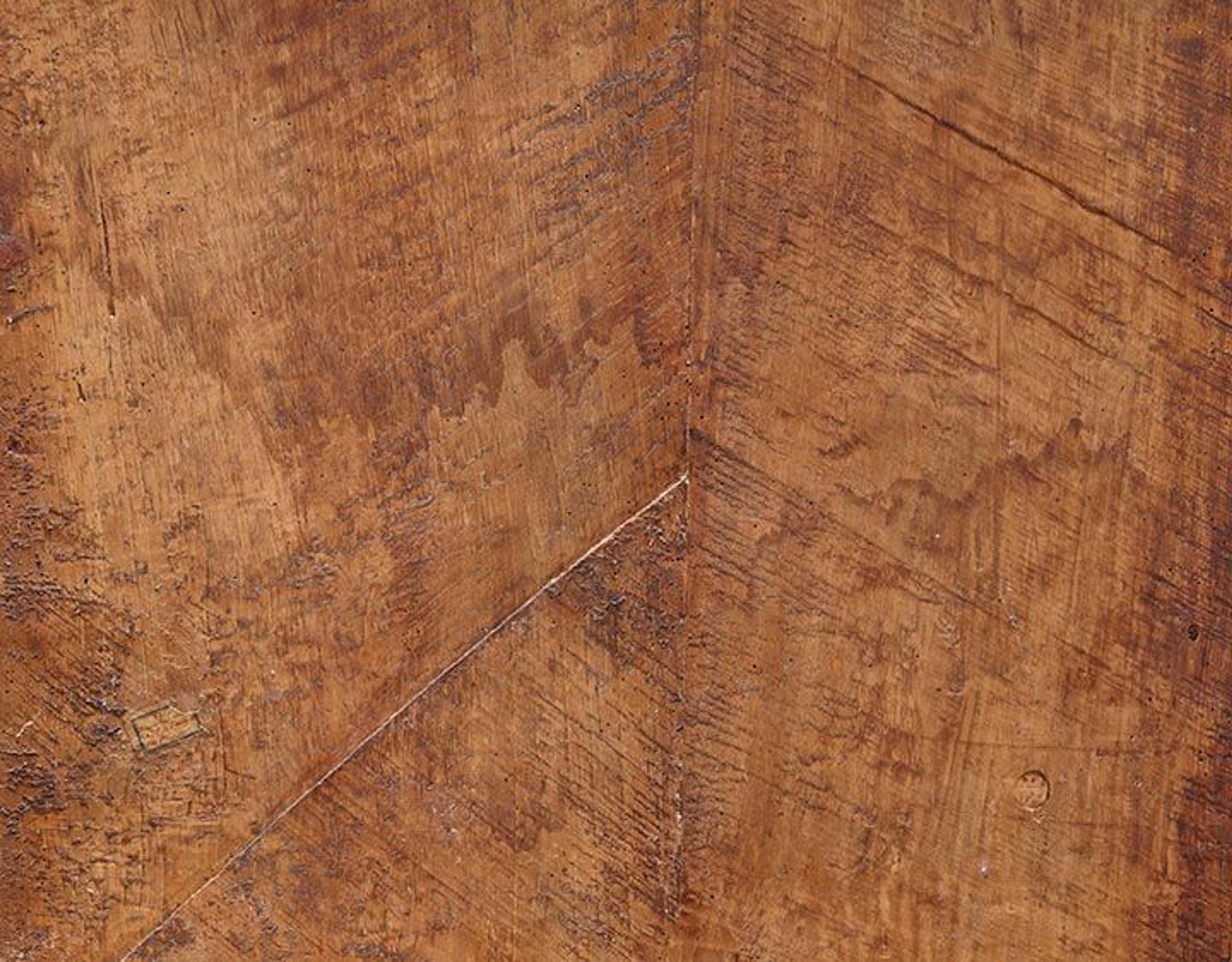
A close-up of the panel's back surface showing the original, 16th-century tool marks left by handsaws and adzes in the construction of the panel. Photo by Alexandra Hola
When we examined the painting itself, it was obvious that the varnish had darkened and was obscuring the subtleties in the modeling of the flesh and drapery. There were also areas with extensive pinpoint flake losses—areas about the size of a pinpoint in which paint has flaked off—that had been painted over as part of an earlier conservation treatment. In addition to the traditional varnish layer, there was, unfortunately, a thick layer of resinous wax over the entire surface that also covered the back of the panel. On the front, the wax served as a varnish and had originally saturated the paint layers. On the back, it worked as a barrier to help reduce the moisture exchange between the exposed wood and the surrounding environment. This wax had also penetrated deep into all of the open splits and disjoins and, we knew, would create serious problems for the structural treatment.
While it is fortunate that all three horizontal battens remained on the back of the panel, they were also instrumental in causing the structural damage of the panel support. After the panel was moved in the 19th century from its original location into centrally heated environments—where temperature and humidity fluctuate according to the seasons—the wood began to go through cycles of warping. Because the battens held the panel too rigidly, the constantly changing environment caused the panel to warp permanently and eventually tear itself apart by cracking where the panel was at its weakest.
The center join had completely failed through its entire length, the other two joins had partially failed, and shorter splits had developed. Additionally, the constant expanding and contracting of the wood also caused each individual plank to warp. The overall effect of this warping is a surface that peaks and dips, often referred to as washboarding.
In light of these conditions, we had two clear objectives for the conservation of this work. First, we would remove the darkened and obscuring surface coating and overpaint, and restore the painted surface. Second, we would stabilize the panel support by repairing the splits and disjoins and providing a new system of support.
Before we began the structural treatment, Conservator Karen Thomas carefully removed the varnish and the darkened resinous wax coating on the surface, as well as the overpaint and old gesso fillings from earlier conservation treatments. The painting was then transferred to the panel studio for the structural treatment. After laying the panel face up, we removed the frame, which we left on during the surface cleaning to provide badly needed support to the fragile panel.
With the frame removed, we found white gesso drips along the edges of the panel, revealing that the panel had been gessoed while lying down horizontally (the liquid drips flow downward) and that, therefore, the panel edges had never been trimmed. Because of this, we were certain that the painted composition was complete.
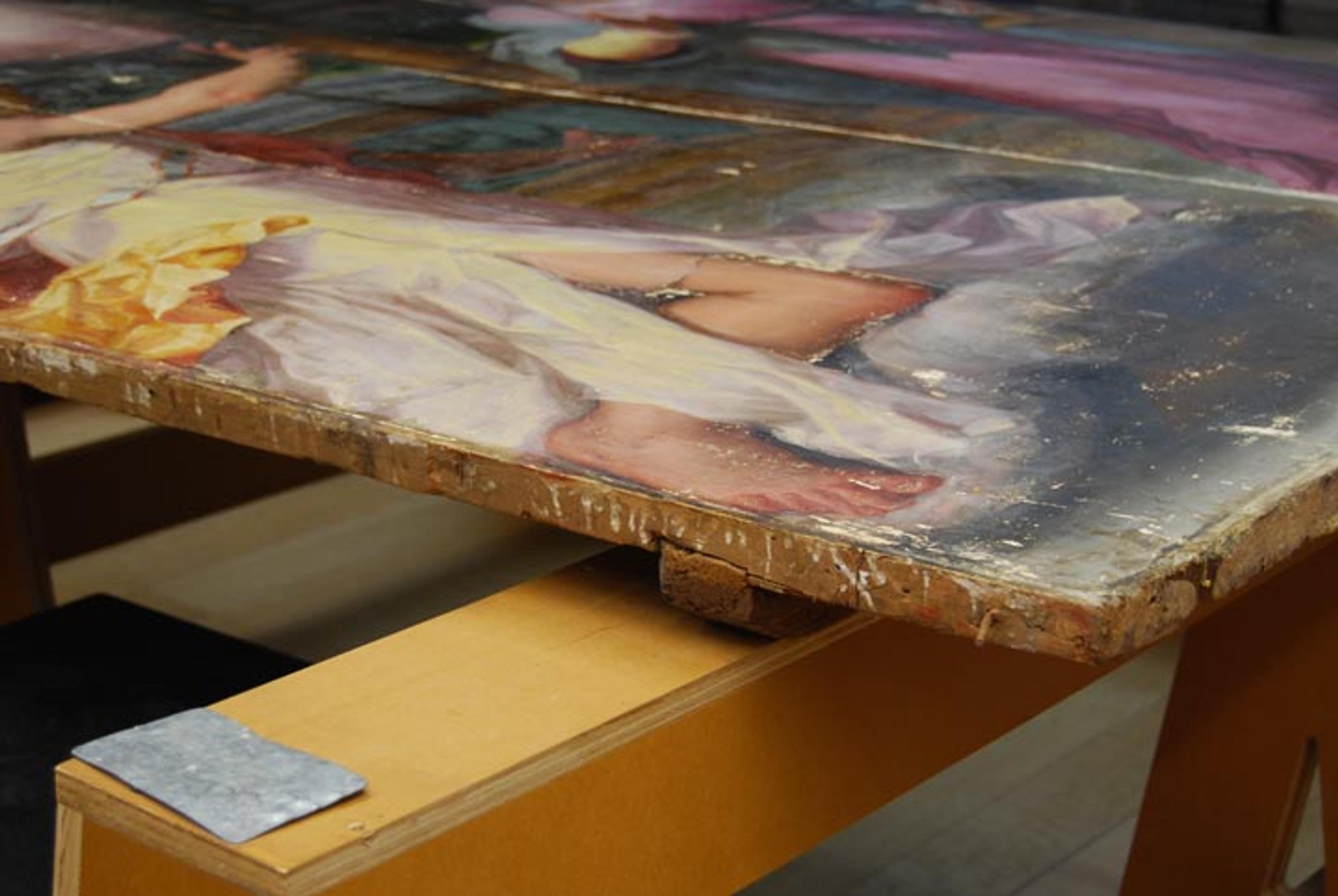
White gesso drips along the edges of the panel indicate that the panel edges had never been trimmed. This tells us that we are looking at the full original work, rather than a section of it. Photo by George Bisacca
We then used sash clamps to push the three original cross battens out of their tracks. This not only helped to release the stress that had accumulated in the panel but allowed us to better understand the extent of the splits and cracks they had caused. Examining the center join, we saw that the paint and gesso had unfortunately cracked and separated along the entire length of the split.
While this was unfortunate for the painted composition, it did provide us with an ideal opportunity: we could—without causing additional damage to the painted surface—separate the panel into two halves. Large structural treatments are often more manageable when undertaken on smaller sections, so separating the panel gave us greater access to the various areas that needed repair. Additionally, with the joint faces fully exposed, we could more effectively clean and prepare the gluing surfaces to ensure a strong and reliable repair.

Cutting through the last remaining wood fibers connecting the two halves of the panel. Photo by Alan Miller
After carefully cutting through the last remaining attached wood fibers, we separated the panel into two halves without further damaging the painted surface.
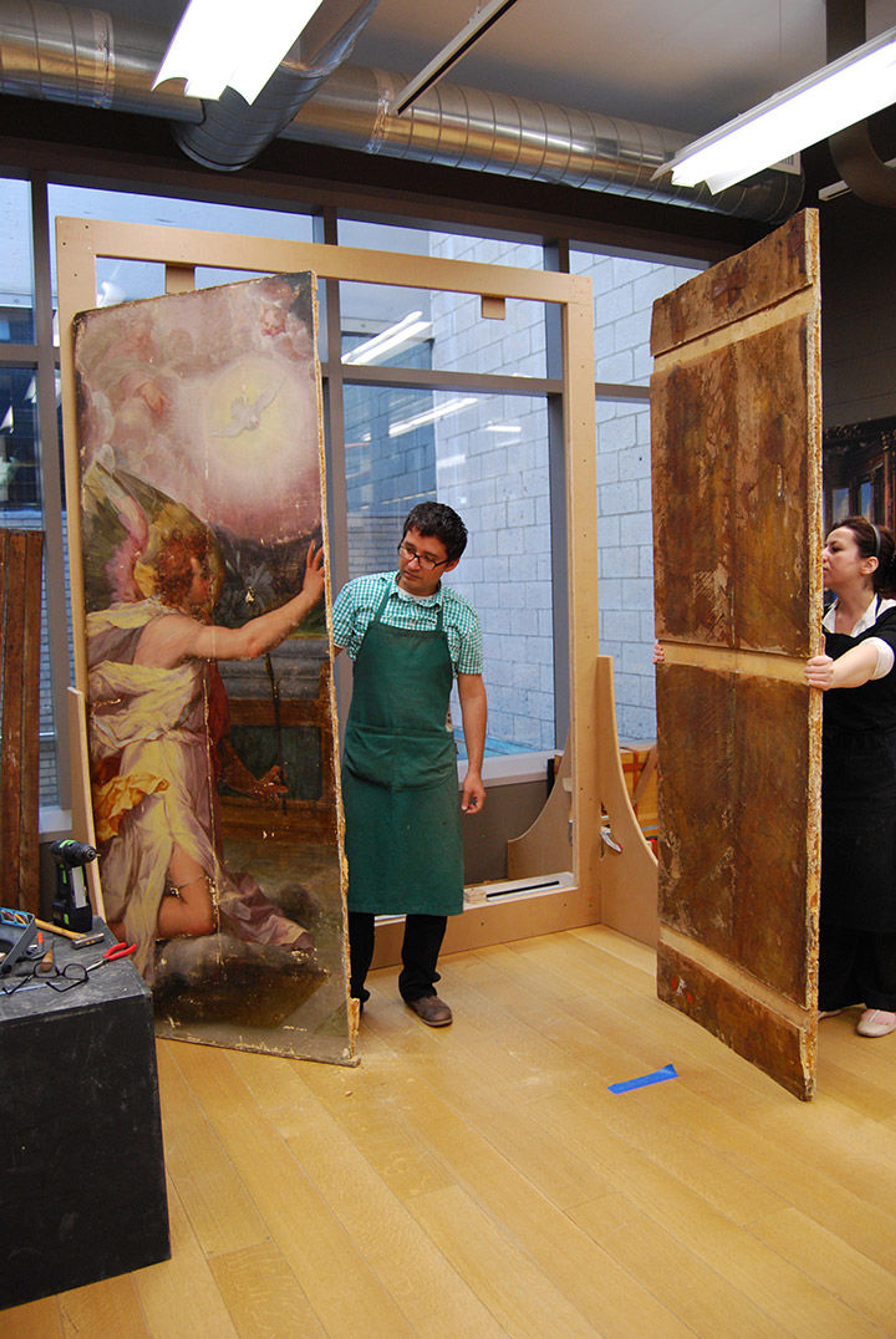
Alan Miller and Alexandra Hola examining the two separated halves of the panel. Photo by George Bisacca
In my next post, I'll discuss the continuation of the structural work on the panel, including the repair of the splits, the rejoining of the two halves, and the construction of a new, secondary support solution.
Related Link
See all blog posts related to the conservation of Peter Candid's The Annunciation.
